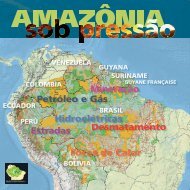Download - RAISG - Instituto Socioambiental
Download - RAISG - Instituto Socioambiental
Download - RAISG - Instituto Socioambiental
You also want an ePaper? Increase the reach of your titles
YUMPU automatically turns print PDFs into web optimized ePapers that Google loves.
MMN1Miningin AmazoniaminingSince the beginning of European conquest in Amazonia there has been a continuous searchfor ‘El Dorado,’ promoted by the stories of the enormous mineral wealth contained in theregion. For centuries prospecting and mining was concentrated in the extremely rich gold and silvermines of the Andean region. It was only in the 20th century with the discovery of large mineral deposits,like the Serra dos Carajás in Brazilian Amazonia (in 1967), that mining activities began to spread,today covering much of the region, whether in the form of industrial production plants or concessionaryblocks, as well as illegal mining.During this period the increase in the prices of precious minerals, the growing demand for otherstrategic minerals (aluminum, iron, titanium, vanadium and so on), and the need in the region’s countriesto generate income through the use of Amazonia’s natural resources, has made mining a majorsource for economic growth; more recently, national development policies have included mining asone of the fundamental sectors for generating jobs and fighting poverty.Those policies encouraged exploration and prospecting in Amazonia, which has revealed itsgreat mining potential. However this growth in the mining industry has largely ignored the socio-environmentalimpacts that it produces. As was pointed out in the previous chapter on hydrocarbons, theseparation and lack of coordination between different sector-based policies for extractive industriesenables the development of mining blocks inside protected areas and Indigenous Territories, as thischapter will show.ContextThe Amazonian republics continued the colonial legal and political tradition of attributing theownership of mineral resources to the State, irrespective of the type of land tenure (private, collective orpublic). The range of different types of land rights found in Amazonia does not restrict the possibility ofundertaking sub-surface mining activities. Hence each government reserves the right to grant concessionsto third parties for surveying, extraction and sale of these resources.In 2012 Colombia announced a moratorium on mining activities in the Amazonian region. Thesocio-environmental sector of Colombia’s civil society persuaded the government to use more cautionin responding to the huge volume of applications for mining concessions. The government suspended,for ten years, the approval of any mining concessions until an objective selection processes could beestablished to allocate the 201 mining blocks planned for the region. Meanwhile Brasil is promotingmining exploration on a large scale in Amazonia, while the National Congress is currently discussing aBill to permit mining surveys and extractive activities in Indigenous Territories.An important case that combines the generation of hydroelectricity with mining activities is now takingplace in Brazilian Amazonia, in the region of the Volta Grande (Big Bend) of the Xingu river, where permissionfrom the environmental sector is in the process of being granted for what will be the largest openpit gold mine in the country. The Canadian mining company Belo Sun plans to install its mining operationswithin 16 km of the Belo Monte hydroelectric plant, which will provide cheap energy for the mine beginningin 2015. The ambitious plans for expanding hydroelectric capacity along the rivers of Brazilian Amazonialikely driving the huge expansion in new mining projects in the region.Despite the legislation in force, illegal mining activities have increased across the region overthe last few decades, producing increasingly larger and more uncontrollable impacts, very often placingat risk the health of entire local communities. Contamination of water with heavy metals such asmercury has long-term health impacts on the communities exposed to these waterways, even whenthey are located at large distances downstream from the mines.Alunorte, the world’s largest aluminum refinery, inaugurated in 1995, consumes energy from theTucuruí Hydroelectric Plant (UHE). Barcarena, Pará, Brasil. © Paulo Santos, 2006 Areas covered with mining concessions cover a total of1.6 million km 2 , representing 21% of Amazonia’s surface Most of these areas (50.8%) are still under tender,followed by those under exploration (30.8%) Guiana is the country with the largest proportionof its Amazonian territory covered by mining concessions Areas covered with mining concessions already occupy15% of the PNAs and 19% of the ITs in Amazonia The sharp rise in the price of gold in recent yearshas stimulated illegal mining in Amazonia,generating considerable socio-environmental impactsThe world’s largest open-pit iron mine, owned by Vale, in Carajás. Pará, Brasil.© Pedro Martinelli, 1996Ä In the Madre de Dios region the rateof deforestation related to small-scalegold mining was 292 ha/yearbetween 2006 and 2009.¾ In Guyana the deforestation causedby gold mining tripled between2001-2002 and 2007-2008.¸ Mining poses a threat to indigenous territoriesin Brasil; 79% (407,300 km 2 ) of the total areacovered by mining concessions in ITs in Amazoniaare located in Brasil.<strong>RAISG</strong> 30 Amazonia under Pressure – Mining Mining – Amazonia under Pressure 31 <strong>RAISG</strong>ÄCartographic sources for the theme Mining: • BOLIVIA: FAN, 2009 • BRASIL: <strong>Instituto</strong> Brasileiro de Geografia e Estatística - IBGE, Malha Municipal 1:1.000.000, 2005 • COLOMBIA: Fundación Puerto Rastrojo (Atlas de la Amazonía Colombiana), 2001;IGAC, 2010 • ECUADOR: Ministerio de Transporte y Obras Públicas, 2006 • PERÚ: Ministerio de Transporte y Comunicaciones - MTC, 2008 • SURINAME: Digital Chart of World, 1993 • VENEZUELA: <strong>Instituto</strong> Geográfico de Venezuela Simón Bolívar, 2003.Ocean and relieve: World Physical Map, U.S. National Park Service, in ArcGIS Online Services.¾¸







